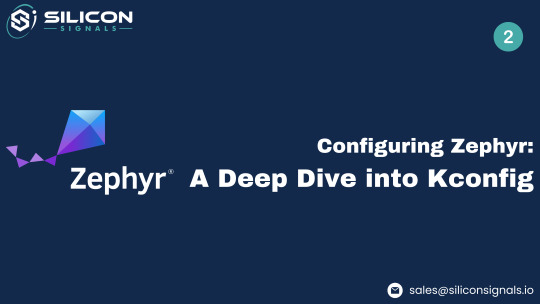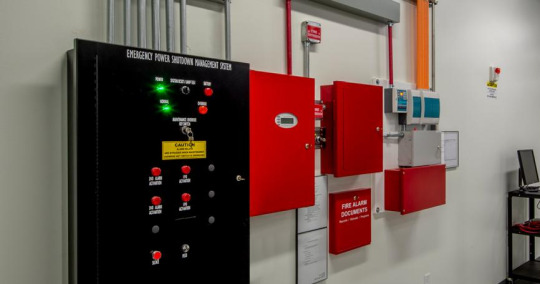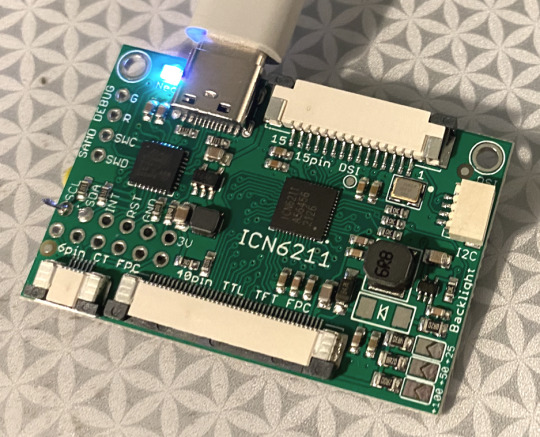#EmbeddedSystems
Explore tagged Tumblr posts
Text
Super Tiny RP2040/ESP32 Display Development Board
Compact RP2040/ESP32 Powered Display board with Type-C connector, keeps it up to date, easier to use
Support us on Kickstarter today

2 notes
·
View notes
Text
Configuring Zephyr: A Deep Dive into Kconfig
We presented The Zephyr Project RTOS and illustrated a personal best practice for beginning with "Zephyr" in an earlier blog post. A custom West manifest file is a great way to guarantee that your code is always at a known baseline when you begin development, as you saw in that blog post. Following the creation of your custom manifest file and the establishment of your baseline repositories using West, what comes next in your Zephyr journey?

Enabling particular peripherals, features, and subsystems is one of the first steps in putting embedded software into practice. Some MCU manufacturers, like STM32, Microchip, and TI, have tools in their IDEs that let developers add subsystems to their codebase and enable peripherals in their projects. These tools, however, are closely related to the MCUs that the vendors sell. Applying these tools' functionality to other MCUs is challenging, if not impossible.
However, we can enable a specific MCU subsystem or feature using a vendor-neutral mechanism provided by The Zephyr Project RTOS. For people like me who don't like GUIs, this mechanism can be used with a command line. The name of this utility is "Kconfig." I'll go over what Kconfig is, how it functions, and the various ways we can use it to incorporate particular features and subsystems into our Zephyr-based project in this blog post.
WHAT IS KCONFIG?
Kconfig is still utilized today as a component of the kernel compilation process, having been initially created as part of the Linux kernel. Kconfig has a particular grammar. Although fascinating, the specifics of how Kconfig is implemented in the Linux kernel are outside the purview of this blog post. Alternatively, if you're interested, you can read my article here: (https://www.linux-magazine.com/Issues/2021/244/Kconfig-Deep-Dive), which walks through the Kconfig source code. However, after seeing an example, it's simple to become familiar with the format of a "Kconfig"—the slang term for a specific configuration option. The Kconfig system consists of three primary components.
First, there is the collection of Kconfig files scattered across different OS codebase directories. For example, if we look under "drivers/led" within the Zephyr codebase, we see a file named Kconfig with the following contents: menuconfig LED bool "Light-Emitting Diode (LED) drivers" help Include LED drivers in the system configurationif LED...config LED_SHELL bool "LED shell" depends on SHELL help Enable LED shell for testing.source "drivers/led/Kconfig.gpio"...endif # LED
Using the if statement, the line that begins with "menuconfig" tells the Kconfig system that "LED" contains a number of feature options that are only visible if the "LED" feature is enabled. The user can then activate the "LED_SHELL" option if the "LED" feature is enabled. The result of this configuration option is a Boolean, which determines whether this feature is enabled or disabled, as the line that follows shows. If a configuration option refers to a particular configuration parameter, the result can also be an integer in addition to a Boolean. The line that starts with "depends" indicates that in order for the "LED_SHELL" feature to be visible, the "SHELL" feature needs to be enabled. As a result, only after the "LED" and "SHELL" features have been enabled will the "LED_SHELL" feature become visible. A more detailed explanation of the feature can be found in the two lines that begin with "help". Last but not least, the final line before the "endif" lets us refer to additional Kconfig files, which aids in classifying components. As though they were copied and pasted, the features of the referenced file are present in the current file. It is crucial to remember that the path to "source" comes from the Zephyr codebase's root.
HOW SHOULD YOU USE KCONFIG?
A collection of applications that enable users to enable or disable the features listed in all Kconfig files make up the second component of the Kconfig infrastructure. Zephyr provides a Visual Studio Code extension that enables users to carry out this task with a graphical user interface. For command line enthusiasts like myself, the VS Code extension provides an alternative to utilizing a graphical user interface. In order to configure Zephyr appropriately, the extension can accept a file, which is the final component of the Kconfig infrastructure and contains a set of configuration options that can be turned on or off. The following snippet shows an example. CONFIG_BT=yCONFIG_BT_PERIPHERAL=yCONFIG_BT_GATT_CLIENT=yCONFIG_BT_MAX_CONN=1CONFIG_BT_L2CAP_TX_MTU=250CONFIG_BT_BUF_ACL_RX_SIZE=254
There is nothing complicated about the file format. "CONFIG_" appears at the start of each line, and then the configuration option's name. After the "=" symbol, the line either ends with a "y" to activate the feature or a "n" to deactivate it. In the example above, we configure the stack parameters and activate the Bluetooth stack in Zephyr along with specific stack features. "prj. conf," which contains user-defined features, is the default file in the majority of Zephyr-based applications.
CONCLUSION
The Zephyr Project RTOS provides a robust, vendor-neutral mechanism called the Kconfig infrastructure that allows us to fully configure our entire application. It can be used to control particular subsystems and peripherals within the MCU in addition to turning on or off individual stacks within the RTOS and setting configuration parameters.
Ready to bring your embedded systems to life with optimized configurations and robust solutions? We specialize in hardware design and software development tailored to your project needs. Whether you're configuring peripherals or diving deeper into Kconfig for your Zephyr-based applications, our experts are here to support you every step of the way.
👉 Contact Us Today and let's transform your embedded ideas into reality!
2 notes
·
View notes
Text
ESP32 ItsyBitsy is in final testing zOne!
OK, after a long hiatus, the ESP32 Itsy Bitsy prototypes are built and ready for testing! We first designed this board Feb 20, 2020 - and it's been waiting oh so patiently for its turn. The ESP32 Pico module packs 8 MB of flash and 2 MB of PSRAM. Despite its small size this board can handle fairly complex programs. This board is very small but has lots of pins, with a USB-serial converter, NeoPixel, reset and user button, Stemma QT connector, and a 5V-logic output specifically for driving NeoPixels. to do my final 'all in one' test we're reading temperature and humidity from an I2C sensor, sending it to IO, then reading back the onboard NeoPixel color from the dashboard. It's an excellent way to make sure the whole thing is working the way we like. Last up, we'll do a low-power test, and then it'll be ready for fabrication!
#espressif#esp32#adafruit#ItsyBitsy#NeoPixel#hardwaretesting#pcbdesign#micropython#iotprojects#embeddedsystems#prototyping#makersmovement#technologyinnovation#electronicengineering#diyelectronics
8 notes
·
View notes
Text
Teksun offers Wearable Product Development Services, including low-power designs, smartwatches, wireless earbuds for connectivity with IoT devices, etc. To know more about browse: https://teksun.com/ Contact us ID: [email protected]
2 notes
·
View notes
Text

Discover the future of warehouse automation with Auckam Technologies. From intelligent electronics design to scalable AI-driven robotics systems, we help you build reliable, next-gen warehouse robots ready for 24/7 operations. 🔗 Visit: www.auckam.com 📞 Call: +91 63747 82199
#WarehouseRobots#AIinWarehousing#SmartLogistics#ElectronicsDesign#AutomationSolutions#RoboticsManufacturing#AIWarehouse#AuckamTechnologies#EmbeddedSystems#IndustrialAutomation#PCBandRobotics#RobotDesign
0 notes
Text
#AAEON#AIInference#EdgeComputing#DualGPU#IntelCore#NVIDIAGPU#MAXER5100#EmbeddedSystems#Innovation#powerelectronics#powermanagement#powersemiconductor
0 notes
Text
🚨 Prevent Electrical Fires Before They Start Did you know that up to 70% of electrical fires are preventable?

Forlinx Embedded presents a smart and efficient solution for electrical fire monitoring systems powered by the FET6254-C SoM.
With real-time monitoring, fast alerts, dual-core architecture, and industrial-grade stability, this solution is ideal for residential, commercial, and industrial applications.
✅ Real-time current, voltage & temperature monitoring ✅ Reliable alerts on overheating, short circuits & more ✅ Dual-core (A-core + M-core) for mission-critical stability ✅ Rich interfaces: CAN-FD, UART, Gigabit Ethernet, LVDS ✅ Designed for industrial environments

#Forlinx#EmbeddedSystems#ElectricalSafety#FirePrevention#IoT#SmartMonitoring#FET6254C#IndustrialControl
0 notes
Text
Embedded Linux for Firmware Development

Explore how Monarch Innovation leverages Embedded Linux for advanced firmware development. From custom board support packages (BSPs) to real-time operating systems and device drivers, we deliver robust, scalable, and secure embedded solutions across industries. Enhance your embedded systems with expert Linux-based firmware development that ensures flexibility, reduced time-to-market, and seamless hardware integration.
#embedded systems#firmware development#embedded software development#embeddedsystems#embedded firmware development
0 notes
Text
Embedded Systems Market Transformation: The Backbone of Modern Digital Infrastructure
Embedded systems are devices that include a microprocessor or microcontroller and its supporting circuitry. Unlike general-purpose computers, embedded systems are designed to perform predetermined tasks often with real-time computing constraints. They are embedded as part of a complete device often including electrical and mechanical components. Common examples include anti-lock braking systems in vehicles, industrial automation control systems, routers, set-top boxes and medical equipment.
Get More Insights on Embedded Systems https://www.patreon.com/posts/embedded-systems-131305089

0 notes
Text
Top IoT Companies in India: Pioneers Driving the Future of Connectivity
The Internet of Things (IoT) has emerged as a revolutionary force in the global tech ecosystem, connecting billions of devices and enabling smarter living and working. India, with its booming IT industry, rapidly evolving startup culture, and government-backed digital initiatives, is quickly becoming a global hub for IoT innovation. From smart cities and agriculture to industrial automation and healthcare, Indian companies are playing a critical role in shaping the future of IoT. In this article, we explore the top IoT companies in India that are making significant strides in the industry with their cutting-edge solutions and transformative impact.
website:-https://theomnibuzz.com/draft--my-post-titletop-iot-companies-in-india--pioneers-driving-the-future-of-connectivity
0 notes
Text
#linux kernel#yoctoproject#linuxdebugging#embeddedsystems#embeddedsoftware#embeddedtechnology#firmware
1 note
·
View note
Text

The famed ICN6211 DSI to RGB prototype arrives! 🔧🔬💻
OK we got our prototype PCB of a SAMD21 + ICN6211 dev board in hand, and we're starting to bring it up. first up, we'll get I2C running so we can scan for the ICN6211 chip. then its time to pore over an exfiltrated datasheet to map out all the registers to configure the two graphics ports. finally - we'll try to get this running on a mainline linux kernel with a device tree overlay. this should be super easy, right…?
#adafruit#electronics#TechInnovation#HardwareDevelopment#PrototypeUnveiling#EmbeddedSystems#ICN6211#SAMD21#I2CProtocol#DataSheets#LinuxKernel#DeviceTreeOverlay
6 notes
·
View notes
Text

You can purchase the Arduino Leonardo R3 board for just Rs. 652.00 exclusively on quartzcomponents.com. This offer provides an affordable opportunity to acquire this versatile microcontroller board for your electronics and programming projects. Don't miss out on this budget-friendly deal!
#arduinoleonardo#leonardo#microcontroller#makerspace#electronicsprojects#programminglife#diyelectronics#embeddedsystems#hardwarehacking#stem#digitalprototyping#techinnovation#circuitdesign#opensourcehardware#creativecoding#electronicaccessories
4 notes
·
View notes
Text
Rugged Embedded System Market Faces New Challenges Amid Growing Cybersecurity and Supply Chain Risks
The rugged embedded system market is experiencing robust growth due to increasing demand across defense, industrial, transportation, and energy sectors. These specialized systems are designed to operate reliably in harsh environments—extreme temperatures, vibrations, moisture, dust, and electromagnetic interference. As industries become more digitized and reliant on automation, the need for rugged solutions continues to rise.

Market Overview
Rugged embedded systems are compact, durable computing devices with embedded software tailored for mission-critical applications. Unlike general-purpose computers, these systems prioritize reliability, minimal maintenance, and long life cycles. The market includes hardware (boards, systems, modules) and software (real-time operating systems, middleware), all optimized for rugged performance.
In 2024, the market size is estimated to exceed USD 5 billion, with projections indicating steady growth through 2030. The compound annual growth rate (CAGR) is expected to remain above 7%, driven by sectors that demand continuous operation in extreme conditions.
Key Drivers of Growth
One of the primary growth drivers is the defense and aerospace industry. Military applications, such as battlefield communication systems, drones, and surveillance units, require rugged embedded platforms that function without fail. Governments worldwide continue to invest in smart military infrastructure, further accelerating demand.
Industrial automation is another significant driver. With the rise of Industry 4.0, smart factories rely on rugged embedded systems for controlling robotic systems, monitoring sensor networks, and managing industrial IoT operations. These systems must perform flawlessly in settings where shock, heat, and contamination are constant threats.
The transportation sector also plays a vital role. Railways, maritime fleets, and automotive manufacturers employ rugged systems for fleet management, navigation, engine control, and safety monitoring. As autonomous vehicles and connected infrastructure evolve, the demand for rugged computing systems with enhanced processing power and connectivity grows.
Energy and utilities, especially oil and gas, use rugged embedded systems in offshore rigs, pipeline monitoring, and power grid control. These systems help reduce downtime and enhance safety, offering long-term returns on investment.
Technological Advancements
The rugged embedded system market is evolving rapidly with technological innovations. The integration of AI and machine learning into rugged systems is a notable trend, enabling predictive maintenance, real-time analytics, and adaptive control systems.
Additionally, the move towards modular and scalable architectures allows developers to customize systems for specific applications while reducing time-to-market. These platforms are increasingly leveraging edge computing, enabling data processing at the source rather than relying on centralized cloud infrastructure. This improves response times and minimizes the risks associated with network latency or outages.
5G connectivity is also being introduced into rugged systems, enhancing real-time data transmission and supporting advanced applications like augmented reality for field maintenance and operations.
Market Challenges
Despite strong growth, several challenges persist. High development and production costs can hinder adoption, especially for small- and medium-sized enterprises. Designing systems that meet stringent environmental and safety certifications, such as MIL-STD-810 and IP ratings, requires substantial R&D investment.
Supply chain disruptions, particularly in semiconductor components, can delay manufacturing and increase costs. The market also faces increasing pressure to balance performance with power efficiency, particularly in remote or mobile applications with limited access to power sources.
Furthermore, cybersecurity concerns are rising as rugged systems become more connected. Protecting these systems from cyber threats is crucial, especially in critical infrastructure and defense applications.
Regional Insights
North America holds a dominant share of the rugged embedded system market, primarily due to its advanced defense sector and strong presence of key players. Europe follows closely, with major contributions from aerospace and rail transportation industries. The Asia-Pacific region, particularly China, Japan, and India, is expected to witness the fastest growth due to rapid industrialization, expanding defense budgets, and infrastructure development.
Future Outlook
The rugged embedded system market is poised for sustained expansion, fueled by growing demand for reliable computing in harsh environments. As digital transformation accelerates across sectors, the market will continue to evolve, with a strong focus on AI integration, edge intelligence, and modular design.
Companies that invest in innovation, offer flexible customization, and meet evolving industry standards will be well-positioned to lead in this competitive landscape. Despite challenges, the long-term outlook for the rugged embedded system market remains optimistic.
0 notes
Text

Explore the future of electronics with high-performance PCB design and manufacturing. This exploded view showcases the detailed layers of modern embedded systems—engineered for reliability, thermal efficiency, and compact architecture. Learn more at www.auckam.com – your partner in end-to-end electronics manufacturing, PCB design, and embedded hardware solutions.
#PCBA#ElectronicsDesign#EmbeddedSystems#PCBManufacturing#HardwareEngineering#ElectronicDeviceDesign#OEMSolutions#EMSPartner#IoTHardware#Auckam#ElectronicsIndia#SmartManufacturing#PCBDesignExperts#ElectronicEngineering#AuckamTechnologies
0 notes